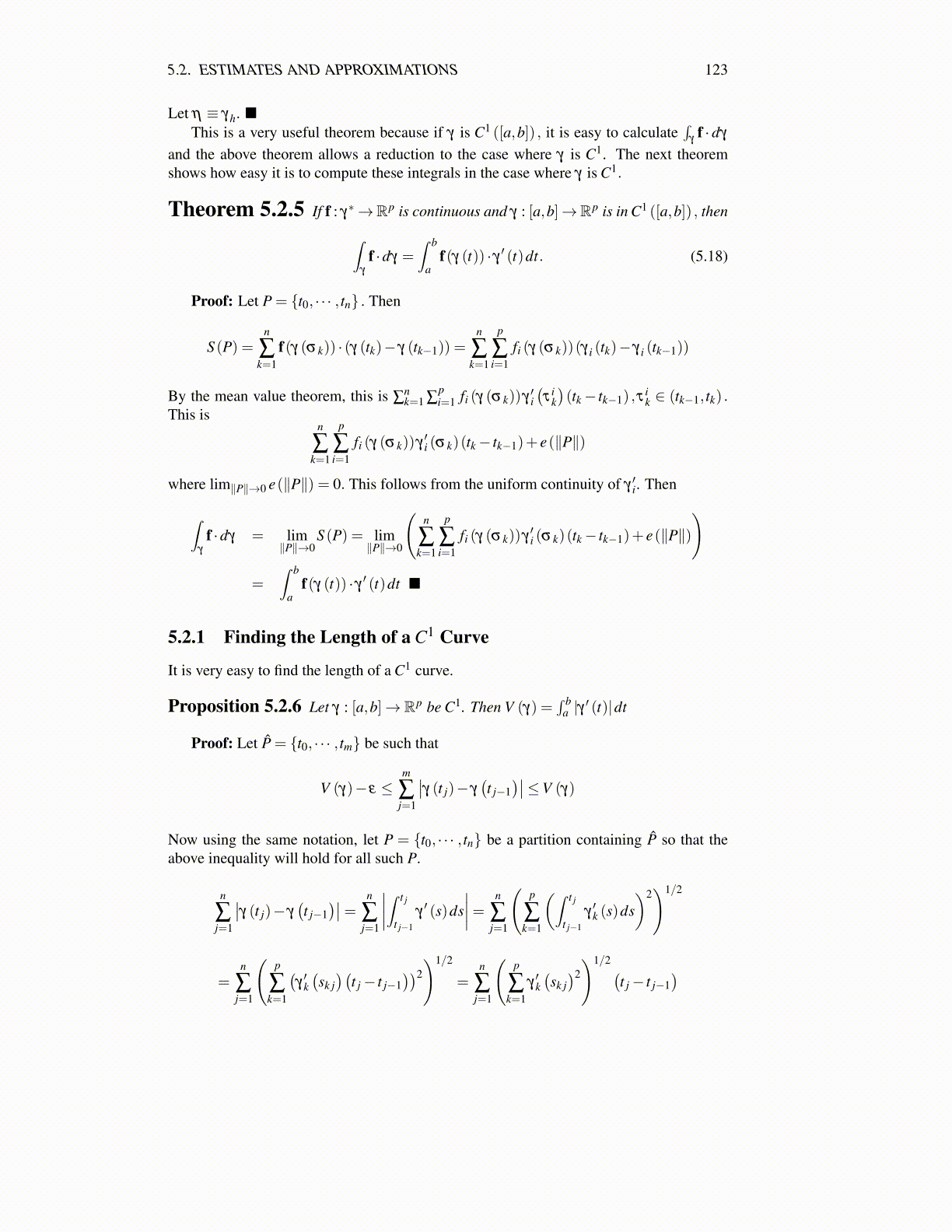
5.2. ESTIMATES AND APPROXIMATIONS 123
Let η ≡ γh. ■This is a very useful theorem because if γ is C1 ([a,b]) , it is easy to calculate
∫γ
f · dγ
and the above theorem allows a reduction to the case where γ is C1. The next theoremshows how easy it is to compute these integrals in the case where γ is C1.
Theorem 5.2.5 If f : γ∗→Rp is continuous and γ : [a,b]→Rp is in C1 ([a,b]) , then∫γ
f ·dγ =∫ b
af(γ (t)) · γ ′ (t)dt. (5.18)
Proof: Let P = {t0, · · · , tn} . Then
S (P) =n
∑k=1
f(γ (σ k)) · (γ (tk)− γ (tk−1)) =n
∑k=1
p
∑i=1
fi (γ (σ k))(γ i (tk)− γ i (tk−1))
By the mean value theorem, this is ∑nk=1 ∑
pi=1 fi (γ (σ k))γ ′i
(τ i
k
)(tk− tk−1) ,τ
ik ∈ (tk−1, tk) .
This isn
∑k=1
p
∑i=1
fi (γ (σ k))γ′i (σ k)(tk− tk−1)+ e(∥P∥)
where lim∥P∥→0 e(∥P∥) = 0. This follows from the uniform continuity of γ ′i. Then
∫γ
f ·dγ = lim∥P∥→0
S (P) = lim∥P∥→0
(n
∑k=1
p
∑i=1
fi (γ (σ k))γ′i (σ k)(tk− tk−1)+ e(∥P∥)
)
=∫ b
af(γ (t)) · γ ′ (t)dt ■
5.2.1 Finding the Length of a C1 Curve
It is very easy to find the length of a C1 curve.
Proposition 5.2.6 Let γ : [a,b]→ Rp be C1. Then V (γ) =∫ b
a |γ ′ (t)|dt
Proof: Let P̂ = {t0, · · · , tm} be such that
V (γ)− ε ≤m
∑j=1
∣∣γ (t j)− γ(t j−1
)∣∣≤V (γ)
Now using the same notation, let P = {t0, · · · , tn} be a partition containing P̂ so that theabove inequality will hold for all such P.
n
∑j=1
∣∣γ (t j)− γ(t j−1
)∣∣= n
∑j=1
∣∣∣∣∫ t j
t j−1
γ′ (s)ds
∣∣∣∣= n
∑j=1
(p
∑k=1
(∫ t j
t j−1
γ′k (s)ds
)2)1/2
=n
∑j=1
(p
∑k=1
(γ′k(sk j)(
t j− t j−1))2
)1/2
=n
∑j=1
(p
∑k=1
γ′k(sk j)2
)1/2 (t j− t j−1
)